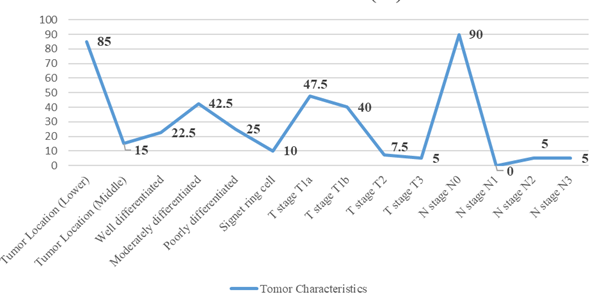Incidence of Anastomotic Bleeding, Anastomotic Leakage, SSI and Operative Time Following Linear Cutting Stapling Device Gastro-Jejunostomy
Abstract
Background: The condition known as gastric cancer (GC) is complex and complicated. In both rich and developing nations, it poses a threat to people's physical and psychological well-being and places a heavy financial and health cost on society.
Objective: The aim of the study was to evaluate the Incidence and risk factors of anastomotic bleeding, anastomotic leakage, SSI and operative time following linear cutting stapling device gastro-jejunostomy.
Methodology: The study was a Prospective observational study which was conducted in Department of Surgery, Dhaka Medical college & Hospital, over Six months’ period after approval of protocol using a semi-structured questionnaire through face to face interview. Data were analyzed using a computer programme SPSS 23.0 version.
Results: Total 40 patients were enrolled in this study with the mean age of 57.45±7.04 years and 65% were male. The overall mean BMI of the patients was 21.94±1.61 kg/m2. Among all the respondents 25% had comorbidity. among all the study participants 85% Tumor location was in middle and 47.5% had T1a stage followed by T1b (40%), T2 (7.5%) and T3 (5%) further 90% had N0 stage followed by N2 (5%) and N3 (5%). The mean operation time was 24.6±2.9 minutes with the incidence of anastomotic hemorrhage was 5%, Anastomotic leak 5% and fortunately no SSI had occurred.
Conclusion: This study concluded that the ease and speed with which surgical staplers may be used make them the favored choice.
Downloads
References
Sitarz R, Skierucha M, Mielko J, Offerhaus GJA, Maciejewski R, Polkowsk WP. Gastric cancer : epidemiology, prevention, classification, and treatment. Cancer Manag Res. 2018;10(1):239–48.
Rahman R, Asombang AW, Ibdah JA, Rahman R, Asombang AW, Ibdah JA. Characteristics of gastric cancer in Asia. World J Gastroenterol. 2014;20(16):4483–90.
Pourhoseingholi MA, Vahedi M, Baghestani AR. Burden of gastrointestinal cancer in Asia ; an overview. Gastroenterol Hepatol from Bed to Bench. 2020;8(3):19–27.
Weledji EP. The principles of the surgical management of gastric cancer. Int J Surg Oncol. 2017;2(7):e11.
Bausys R, Bausys A, Vysniauskaite I, Maneikis K, Stratilatovas E, Strupas K. Surgical treatment outcomes of patients with T1-T2 gastric cancer : does the age matter when excellent treatment results are expected ? World J Surg Oncol. 2018;18(1):1–9.
Seo SH, Kim KH, Kim MC, Choi HJ, Jung GJ. Comparative Study of Hand-Sutured versus Circular Stapled Anastomosis for Gastrojejunostomy in Laparoscopy Assisted Distal Gastrectomy. J Gastric Cancer. 2012;12(2):120–5.
Murata Y, Tanemura A, Kato H, Kuriyama N. Superiority of stapled side-to-side gastrojejunostomy over conventional hand-sewn end-to-side gastrojejunostomy for reducing the risk of primary delayed gastric emptying after subtotal stomach-preserving pancreaticoduodenectomy. Surg Today. 2017;47(8):1007–17.
Shahzad HK, Khan MA, Bokhari SG, Durrani AZ, Asif M, Khan IU, et al. Comparative Evaluation Of Conventional Method And Stapled Suture Technique For Intestinal Anastomosis In Dogs. J Anim Plant Sci. 2016;26(6):1614–9.
Maatooq AM, Ssam M. Comparative Study Between Stapler and Hand Sewing in Gastrointestinal Anastomosis. Basrah J Surg. 2017;23(2):21–5
Bae JM. Body mass index and risk of gastric cancer in asian adults: A meta-epidemiological meta-analysis of population-based cohort studies. Cancer Res Treat. 2020;52(2):369–73.
Shahzad HK, Khan MA, Bokhari SG, Durrani AZ, Asif M, Khan IU, et al. Comparative evaluation of conventional method and stapled suture technique for intestinal anastomosis in dogs. J Anim Plant Sci. 2016;26(6):1614–9.
Singha JL, Haq Z, Majid M, Taher MA. Stapled Versus Hand-Sewn Anastomosis in Colorectal Cancer Surgery: A Comparative Study. J Surg Sci. 2019;19(1):8–16.
Kuthe A, Haemmerle A, Ludwig K, Falck S, Hiller W, Mainik F, et al. Multicenter prospective evaluation of a new articulating 5-mm endoscopic linear stapler. Surg Endosc. 2016;30(5):1883–93.
Globocan. The Global Cancer Observatory: Bangladesh. Vol. 906. 2018.
Maconi G, Manes G, Porro GB, Maconi G, Manes G, Porro GB. Role of symptoms in diagnosis and outcome of gastric cancer. World J Gastroenterol. 2008;14(8):1149–55.
Griffen FD, Knight CD Sr, Whitaker JM, Knight CD Jr. The double stapling technique for low anterior resection. Results, modifications, and observations. Ann Surg. 1990; 211:745–751; discussion 751-752.



























